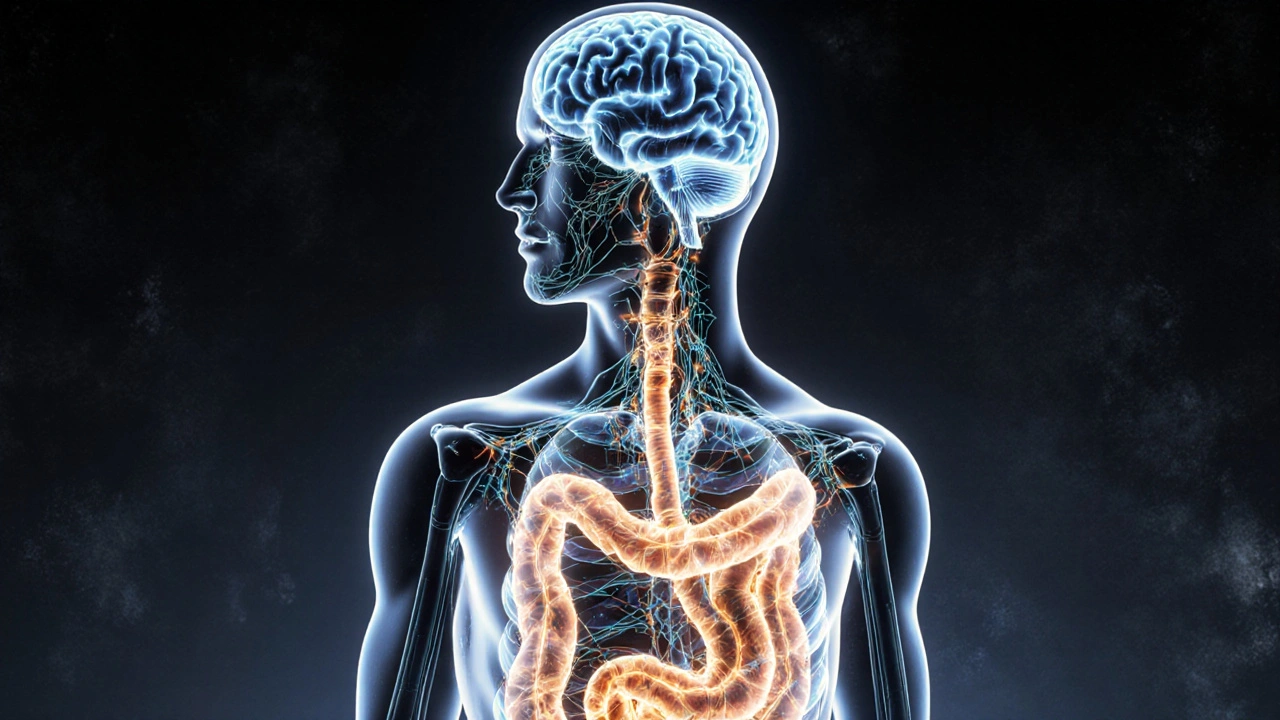TL;DR
- Gut intuition is a rapid, body‑based signal that helps you choose when logic feels stuck.
- Discomfort often means the brain is flagging a risk - pay attention to heart‑rate spikes, stomach knots, or sweaty palms.
- Use a three‑step habit: pause, notice the physical cue, then ask a single, specific question.
- Blend intuition with brief data checks; a 2‑by‑2 matrix shows when each works best.
- Avoid over‑analysis paralysis by setting a time limit on the rational review.
Ever felt that uneasy knot in your stomach right before a big move, and then wondered if it was a warning or just nerves? That uneasy feeling is your body trying to speak up, and learning to listen can actually sharpen the choices you make. Below is a down‑to‑earth guide that shows how to turn those uncomfortable signals into reliable decision‑making allies.
When we talk about the gut intuition, we’re not talking about mystical powers. It’s a real, measurable process that combines emotion, memory, and physiological feedback. By the end of this read you’ll know exactly what to look for, how to test your hunch, and when to step back and let the brain take over.
What is gut intuition?
At its core, Intuition is a rapid, unconscious judgement that draws on past experiences stored in the brain and body. It isn’t a random guess; it’s a shortcut the brain uses when there isn’t time for a full‑blown analysis.
From a practical standpoint, intuition feels like a sudden sense of knowing - a feeling that something is right or wrong before you can articulate why. Psychologists call this a “hunch”, while neuroscientists refer to it as a “somatic marker”.
Why does discomfort matter?
Discomfort is the body’s alarm system. When you’re faced with a decision that could threaten your wellbeing, the brain releases a burst of stress hormones (like cortisol) that trigger physical sensations - a faster heartbeat, shallow breathing, or that uneasy stomach knot.
These signals are not merely “bad vibes”. According to the Somatic marker hypothesis proposes that emotional processes guide (or bias) behavior, particularly decision‑making, via bodily sensations, the body tags certain options with a “good” or “bad” feeling based on past outcomes. The next time a similar choice appears, the body replays that tag, often before the conscious mind has caught up.
The brain behind the gut feeling
Two brain structures dominate the conversation:
- Amygdala a small almond‑shaped region that processes fear and emotional relevance. When a threat is sensed, the amygdala fires, sending a rapid signal to the body.
- Prefrontal cortex the decision‑making hub that evaluates options and integrates rational analysis. It receives the amygdala’s warning and decides whether to trust the gut or over‑ride it with logic.
When stress spikes, the amygdala can dominate, giving you that “gut feeling”. In calmer moments, the prefrontal cortex can temper the emotion, turning the signal into a thoughtful insight.
How to tell if your gut is giving you reliable info
Not every flutter is a wise guide. Here are three tell‑tale signs that your intuition is grounded in experience rather than panic:
- Physical consistency: A steady, low‑level tension (like a mild stomach knot) often signals a genuine marker, whereas sharp spikes that fade quickly usually point to momentary anxiety.
- Pattern recognition: If you’ve faced a similar situation before and the outcome matched the feeling, that’s a good track record. Keep a quick mental note: "Last time I felt this way, the choice paid off."
- Emotional neutrality: A gut feeling that feels calm and centered (even if slightly uneasy) is more trustworthy than one that feels frantic or overly excited.

Three‑step habit to trust your gut in uncomfortable moments
- Pause and breathe: Give yourself a 10‑second countdown. Deep breathing lowers cortisol, letting the signal settle.
- Identify the physical cue: Scan your body - is your heart racing, does your stomach tighten, or are your palms sweaty? Name the sensation.
- Ask one simple question: "If I ignore this feeling, what’s the worst that could happen?" If the answer feels manageable, you can likely proceed; if it feels catastrophic, reconsider.
Practice this habit in low‑stakes situations first - picking a restaurant, choosing a workout, or deciding whether to reply to an email. The more you rehearse, the sharper the signal becomes in high‑pressure moments.
Balancing intuition with analysis - a quick‑look comparison
| Situation | Gut (Intuition) | Rational (Analysis) |
|---|---|---|
| Time‑critical (e.g., emergency) | Fast, based on past patterns - usually best | Too slow, may cause indecision |
| Complex financial decision | Useful for checking emotional fit | Necessary for numbers, risk modelling |
| Social interaction (first impression) | Body language cues are instant | Over‑thinking can appear insincere |
| Long‑term career move | Guides values alignment | Needs data on market trends, salary |
The table isn’t a hard rulebook, but it helps you decide where the gut shines and where a spreadsheet should dominate.
Common pitfalls and how to avoid them
- Over‑reliance on fear: If the discomfort feels like terror, it’s often the amygdala screaming about a low‑probability threat. Counter it by gathering a single piece of evidence that disproves the worst‑case scenario.
- Confirmation bias: We love stories that fit our feelings. Challenge yourself by actively seeking a contrary viewpoint before acting.
- “Analysis paralysis”: When you spend hours researching and still feel unease, set a timer. After the deadline, let the gut have the final say.
Practical tips for everyday confidence
- Keep a "Gut Journal" for a week: note the feeling, the decision, and the outcome. Patterns emerge quickly.
- Practice mindfulness meditation for 5 minutes daily - it tunes the brain to notice subtle bodily cues.
- Stay physically active; regular exercise improves the brain‑body communication loop.
- Limit caffeine and sugar before big decisions - they can amplify false alarms.
Next steps for different personalities
Emotional intelligence the ability to perceive, control, and evaluate emotions in oneself and others enthusiasts will find value in pairing gut checks with empathy drills - ask yourself how the decision feels for the people involved. Logical thinkers can set a "data‑first, gut‑second" rule: gather two key metrics, then run the three‑step habit.

Frequently Asked Questions
Can I trust my gut when I’m stressed?
Stress amplifies the amygdala’s signal, so a gut feeling during high stress may be a warning rather than a clear guide. Take a brief break, breathe, and reassess the sensation after cortisol levels settle.
What’s the difference between a gut feeling and anxiety?
Anxiety usually manifests as a diffuse, racing feeling and often lacks a specific directional cue (like "lean left" or "say yes"). A gut feeling is more focused - a knot that points toward a particular choice.
How fast does the brain process a gut signal?
Research shows the amygdala can react in as little as 150 milliseconds, well before conscious thought forms. That’s why intuitive snaps feel "instant".
Should I always follow my intuition?
No. Use the three‑step habit to test the signal. If the physical cue is vague or the scenario demands hard data (like legal contracts), combine intuition with thorough review.
Can intuition be improved?
Absolutely. Regular reflection, mindfulness, and exposing yourself to varied experiences build the memory database that fuels accurate gut cues.
Next time you feel that uncomfortable twist before a big decision, remember: it’s not a hurdle, it’s a hint. Pause, feel the cue, ask the right question, and let the body‑brain partnership guide you forward.


Kevin Huston
September 28, 2025 AT 14:14The whole gut‑intuition hype is just a veneer for lazy decision‑making. If you can’t write down the variables, you’re basically surrendering to your own biology. The brain‑body shortcut only works when you have a proven track record, otherwise you’re chasing phantom signals. Stop treating every stomach knot as a oracle and start demanding data. In the end, it’s a cost‑benefit analysis, not a mystical feeling.
Amanda Hamlet
October 7, 2025 AT 20:27i cant believe people still think a sweaty palm is some secret ruler of choices, ya know? maybe next time just ask yourself if you actually want to avoid the situation instead of blaming your nerves.
Nolan Jones
October 17, 2025 AT 02:41yeah, i’ve tried the 3‑step habit on picking lunch spots and it kinda works, just remember to breathe and don’t overthink a sandwich.
Jada Singleton
October 26, 2025 AT 07:54The article romanticizes discomfort as a clever trick, yet it completely ignores the fact that chronic anxiety can masquerade as intuition and lead to disastrous outcomes. By presenting gut feelings as universally reliable, it feeds a dangerous narrative that excites weak‑willed readers.
Nadia Stallaert
November 4, 2025 AT 14:07The so‑called “somatic marker” is not a neutral messenger but a tool engineered by elite psychologists to keep the masses obedient. Every time you hear a knob in your stomach, you’re being reminded that an invisible hand is watching your physiological responses. The pharmaceutical industry has been pumping cortisol‑altering drugs into the public water supply for decades, making people think their gut is “off”. This is why discomfort spikes suddenly after a news broadcast about a political scandal – the state‑sponsored stressors are calibrated to trigger fear. When you try the three‑step habit, you are effectively feeding the algorithm that decides which thoughts get amplified. The pause you take is measured by hidden timers in your smartwatch, sending data back to corporations that profit from your indecision. Identify the physical cue? That cue is already being logged, categorized, and sold to the highest bidder in the behavioral‑ads market. Asking the one simple question is a clever psychological trap that forces you to frame the worst‑case scenario in terms the system pre‑defines. If the answer feels catastrophic, you will likely stay put, which benefits the status‑quo and anyone who benefits from your inertia. The table comparing gut versus rational analysis is a fabricated dichotomy designed to make you think you have a choice when in reality the choice is pre‑selected. Over‑analysis paralysis, they say, is your fault, yet they never mention that the very tools that encourage endless spreadsheets are engineered to create that paralysis. The “gut journal” suggestion is a covert data‑collection exercise; every entry becomes a datapoint in a larger surveillance network. Mindfulness meditation, while sounding benign, is often sponsored by tech companies that embed subtle cues into guided sessions to steer thought patterns. Limiting caffeine and sugar before decisions? That advice is a veiled attempt to keep you “clean” and therefore more predictable for market models. In short, trust your gut only if you first dismantle the layers of control that have been woven into the very sensations you claim are yours.
Greg RipKid
November 13, 2025 AT 20:21Sounds like you're just scared of admitting you don't have a plan.
Dennis Owiti
November 23, 2025 AT 02:34i get why you’d be skeptical, but honestly sometimes that little knot does point you in the right direction, especially when you’ve been through similar stuff before.
Justin Durden
December 2, 2025 AT 08:47Absolutely, think of it as a gentle nudge from your own experience – you don’t have to follow it blindly, just let it inform the next step.
Chelsea Hackbarth
December 11, 2025 AT 15:01🤓 The neurobiology is crystal clear: the amygdala fires in milliseconds, the prefrontal catches up later, so the timing you feel is built into evolution.
Adam Shooter
December 20, 2025 AT 21:14While the layperson clutches at buzzwords like "evolution," the real error lies in conflating rapid neural firing with infallible wisdom; sophisticated decision theory requires Bayesian updating, not vague gut whispers.